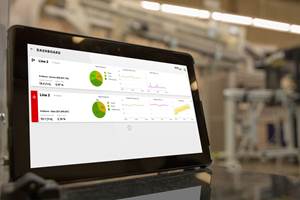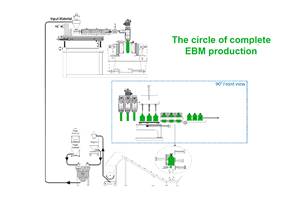Blow Molding: Increase Your Machine Uptime…And Profit
In the early days of industrial blow molding, the processor had quite a few obstacles to overcome.
In the early days of industrial blow molding, the processor had quite a few obstacles to overcome. Many molders formed bad habits. Here are a few that come to mind. Let’s call these industrial blow molding then:
- Material and color changeover times ranged from 8 hr to several days depending on the color and material.
- Poor head designs led to machine downtime and expensive repairs. Many of these occurred every six months or so, amounting to weeks of downtime.
- Long periods of downtime were spent just waiting for the service tech to arrive to begin to solve the problem.
- Very basic manuals, schematics, and sequence of operation did not necessarily pertain to your machine as built. Since there are tons of old machines with many “fix up” repairs over the years, these changes have not been recorded in most cases.
- All of the older machines were semi-automatic and relied on an operator to close the gates and restart the cycle. This gave very unpredictable control of cycle times. And there were no part takeout (PTO) systems.
- Mold changeover took a minimum of a full day or even two. Often this also included changing head tooling.
- Setups from product changes always seemed to cause issues, even though the same changeover was done just the week before.
- Cycle times depended on a comination of parison drop time, press closing time, blow time, exhaust (vent) time, decompression time, clamp opening, gate opening, manual part removal, gate closing, clamp moving to pre-close position.
Due to the many factors involved, these obstacles limited the number of changeovers and different types of parts that could be run on a machine. Fortunately, developments in machine, tooling, and processing technologies have removed many of these obstacles, putting blow molders in a better position to keep the machines and profits up. Let’s look at industrial blow molding now:
- Current head technology allows color changes in about 20 min to a maximum of 1.25 hr for the most difficult changeover. Since some blow molders make up to three color changes a day, the savings are huge and drop right to the bottom line.
- Heads now on the market require little repair or maintenance. The industry has switched from sensitive mica-band head heaters to extruded aluminum and Calrod heaters. After five years of use, these heaters have not experienced one blow-out as compared with hundreds on the mica band heaters, cutting replacement cost and downtime. Further, a properly designed head will eliminate potential galling from metal-to-metal rubbing on the moving internal sections of the flow paths of plastic materials. This was a major cause of overly long color/material changeover times. There are heads on the market that allow disassembly/cleaning/assembly to change color or material within 1 hr.
- It is still not uncommon to have to wait for a service tech to arrive at your plant to fix your machine. But I have found out that about 80% of machine problems today are due to improper setup. These types of problems can be solved by technology that links the supplier directly to your machine for troubleshooting. Most issues can now be identified and resolved in 1 to 2 hr.
- Machine manuals can now be made viewed on the machine operator’s computer screen. No need to try to find the original paper manuals that are stored in a locked supervisor’s office at 3 am.
- Automated part takeout has now become a standard component of the blow molding machine. Automation gives a consistent cycle time. It now also makes sense to include a part-holding fixture with the PTO system. In dual-head operations, the holder prevents the second part from dropping until the operator is finished with the first one. The gain here is possible elimination of a second operator per shift.
- Molds are now designed with quick-change connections for water, air, and hydraulics. Some processors now make complete mold changeovers in 15 min. This means more uptime and more profit in your pocket. The costs to accomplish faster mold changes are nominal. Look at mold positioning gadgets like locator hangers. In many cases, air, water, and hydraulic manifolds mounted directly on the mold will save many hours, thanks to fewer connections to be made. Keep your tools on a wagon for the next changeover. This cuts down on walks across the building to get the necessary tools. The other area of changeover is the head tooling. It’s usually hot, heavy, and large. Simple tables or adjustable stands to support and guide the tooling into place will save time and make changeovers safer.
How much is all this worth? Every second saved adds directly to your bottom-line profit. For example, if we can save 3 sec on a 60-sec cycle time with a dual-head operation, and the mold runs for 7000 hr/yr, the benefit is 30,000 more parts/yr. How do we accomplish this? Make sure there is no more than 1 sec between starting drop of parison and the extruder reaching shot size. It might be possible to bring the pre-close position closer to the mold-close position. (This alone could save 1 sec.) Air blow and vent times are usually the longest parts of the cycle. Shorten the time for air blow and see whether that affects the ability to make an acceptable part. Check the vent/exhaust time of the air inside the part. Make sure the quick-exhaust valve is large enough to vent out a large amount of air in 5 to 6 sec or less. (I have seen this take 10 to 20 sec or longer with an improperly sized exhaust valve.) Have the PTO unit start to remove the part from the mold prior to the gate opening. Only open the mold platens just enough to get the part out with the PTO.
About the Author
Robert Slawska has more than 45 years’ experience in blow molding. His firm, Proven Technology Inc., Hillsborough, N.J., provides engineering/consulting services and equipment to industrial blow molders. Reach him at (908) 359-7888 or email rslawska@aol.com. Website: industrialblowmolding.com
Related Content
How Inline Vision Inspection Can Minimize Scrap in Molding
Once viewed by injection and blow molders as a necessary evil, machine vision technology today can continuously monitor and improve production while reducing costs.
Read MoreFirst Water Bottles With Ultrathin Glass Coating
Long used for sensitive juices and carbonated soft drinks, KHS Freshsafe PET Plasmax vapor-deposited glass coating is now providing freshness and flavor protection for PET mineral water bottles.
Read MoreGet Color Changes Right In Extrusion Blow Molding
Follow these best practices to minimize loss of time, material and labor during color changes in molding containers from bottles to jerrycans. The authors explore what this means for each step of the process, from raw-material infeed to handling and reprocessing tails and trim.
Read MoreBlow Molder with a Mission: CKS Packaging Shares Gains Of Its Phenomenal Growth
From three machines in 1986 to 27 plants nationwide today, this family-owned processor has prospered through unwavering customer service, committed employees and dedicated service to its community.
Read MoreRead Next
Beyond Prototypes: 8 Ways the Plastics Industry Is Using 3D Printing
Plastics processors are finding applications for 3D printing around the plant and across the supply chain. Here are 8 examples to look for at NPE2024.
Read MorePeople 4.0 – How to Get Buy-In from Your Staff for Industry 4.0 Systems
Implementing a production monitoring system as the foundation of a ‘smart factory’ is about integrating people with new technology as much as it is about integrating machines and computers. Here are tips from a company that has gone through the process.
Read More
























